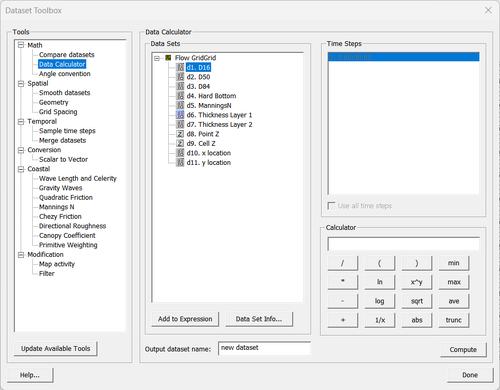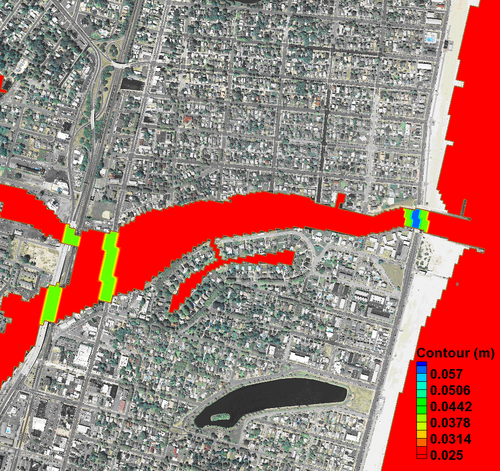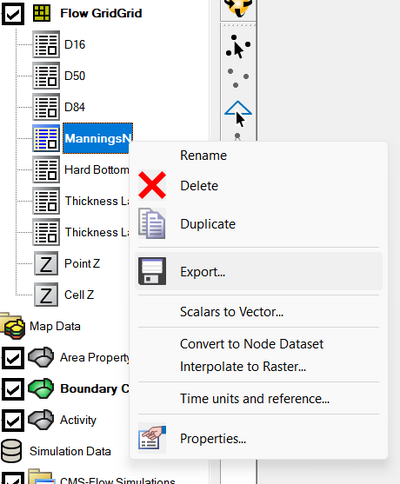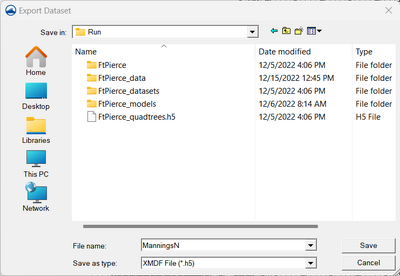CMS-Flow Bottom Friction: Difference between revisions
| (5 intermediate revisions by the same user not shown) | |||
| Line 1: | Line 1: | ||
= Bottom Friction Dataset = | = Bottom Friction Dataset = | ||
==Overview== | ==Overview== | ||
The bottom roughness is specified using the Manning's n coefficient. The option is provided to use a roughness height, or bottom friction coefficient in addition to the Manning's coefficient. The bottom roughness is specified in the ''Bottom Friction Dataset'' section of within the ''Input'' tab of the ''CMS-Flow Model Control'' window (see Figure 2). The ''Bottom Friction Dataset'' is specified at every computational (ocean) cell and is required for each model simulation. Users may edit each grid to specific areas in the shoreline and bottom areas in the ocean. | |||
[[File:SMS Data Create Dataset.png|thumb|left|500px| Figure 1. Dataset Toolbox>Math>Dasta Calculator to create the bottom friction dataset.]] | |||
<br style="clear:both" /> | <br style="clear:both" /> | ||
== Creating == | == Creating == | ||
[[ | [[File:SMS Data Create Dataset ManningsN.png|thumb|right|500px|Figure 2.4. Creation of ManningsN dataset. This process can be applied to create also Bottom Friction and Roughness Height Coefficients]] | ||
Each time a new CMS-Flow simulation is created a bottom friction (roughness) dataset needs to be created using the ''Data'' main menu, 'Dataset toolbox'. | |||
The bottom friction parameter (related to Manning <math>n</math>) is spatially varying (cell-specific) over | The bottom friction parameter (related to Manning <math>n</math>) is spatially varying (cell-specific) over the grid domain or constant. At times a user may desire to represent locations where added friction is needed due to structures or increased turbulence due to sharp changes in current speed. More information on using this feature of CMS-Flow can be found [[CMS-Flow:Bottom_Friction|'''here''']]. | ||
<br style="clear:both" /> | <br style="clear:both" /> | ||
| Line 43: | Line 44: | ||
Exporting the bottom roughness (friction) datasets is useful for creating different project alternatives or when switching from different bottom roughness datasets types such as from ''Manning's n'' to ''Bottom Friction Coefficient'' and back. It is also useful for scripting multiple runs with different project alternatives. | Exporting the bottom roughness (friction) datasets is useful for creating different project alternatives or when switching from different bottom roughness datasets types such as from ''Manning's n'' to ''Bottom Friction Coefficient'' and back. It is also useful for scripting multiple runs with different project alternatives. | ||
[[ | [[File:SMS Explorer Datasets Flow Grid Mannings Export V.13.2.12.png|thumb|left|400px||Figure 5. Manning n contours after modifying the areas under all three bridges.]] | ||
[[ | [[File:SMS Explorer Datasets Flow Grid Mannings Export Save V.13.2.12.png|thumb|none|400px||Figure 6. Exporting the ''Bottom Friction Coefficient'' to an XMDF file.]] | ||
<br style="clear:both" /> | <br style="clear:both" /> | ||
== Advanced Cards == | == Advanced Cards == | ||
'''Table 2. Advanced Cards related to the bottom friction (roughness) dataset''' | '''Table 2. Advanced Cards related to the bottom friction (roughness) dataset''' | ||
| Line 61: | Line 63: | ||
<br style="clear:both" /> | <br style="clear:both" /> | ||
= Wall Friction = | = Wall Friction = | ||
[[ | |||
[[File:CMSFlow_Model_Parameters_GeneralTab_Flow_V13.2.12.png|thumb|right|500px||Figure 6. Wall friction specification in the SMS 11.0 ''CMS-Flow Model Control'' window.]] | |||
The wall friction enhances the flow drag perpendicular to any dry boundary. The wall friction may be turned ''On'' or ''Off'' in the ''Flow'' tab of the ''CMS-Flow Model Control'' window (see Figure 7). The default in SMS is for the wall friction to be ''ON''. Table 3 shows the CMS card used activating the wall friction. | The wall friction enhances the flow drag perpendicular to any dry boundary. The wall friction may be turned ''On'' or ''Off'' in the ''Flow'' tab of the ''CMS-Flow Model Control'' window (see Figure 7). The default in SMS is for the wall friction to be ''ON''. Table 3 shows the CMS card used activating the wall friction. | ||
Latest revision as of 17:41, 15 December 2022
Bottom Friction Dataset
Overview
The bottom roughness is specified using the Manning's n coefficient. The option is provided to use a roughness height, or bottom friction coefficient in addition to the Manning's coefficient. The bottom roughness is specified in the Bottom Friction Dataset section of within the Input tab of the CMS-Flow Model Control window (see Figure 2). The Bottom Friction Dataset is specified at every computational (ocean) cell and is required for each model simulation. Users may edit each grid to specific areas in the shoreline and bottom areas in the ocean.
Creating
Each time a new CMS-Flow simulation is created a bottom friction (roughness) dataset needs to be created using the Data main menu, 'Dataset toolbox'. The bottom friction parameter (related to Manning ) is spatially varying (cell-specific) over the grid domain or constant. At times a user may desire to represent locations where added friction is needed due to structures or increased turbulence due to sharp changes in current speed. More information on using this feature of CMS-Flow can be found here.
Once the Bottom Friction Dataset is created and the CMS-Flow Model Control window closed, a new auxiliary dataset will appear in the SMS Project Explorer (see Figure 3). Table 1. shows a list of the CMS cards related to the bottom friction datasets.
Table 1. SMS Cards related to the bottom friction datasets
| Card | Arguments | Default | Range | Description | Versions |
|---|---|---|---|---|---|
| USE_WALL_FRICTION | CHARACTER | ON | ON | OFF | Turns on or off wall friction | >=3.5 |
| MANNING_N_DATASET | CHARACTER CHARACTER | [<grid file>] [<grid name>//"Datasets/ManningsN"] | none | Grid file name and dataset path for the input Manning's n dataset | >=v3.5 |
| BOTTOM_FRICTION_COEF_DATASET | CHARACTER CHARACTER | [<grid file>] [<grid name>//"Datasets/BottomFricCoef"] | none | Grid file name and dataset path for the input bottom friction coefficient dataset | >=v4.0 |
| ROUGHNESS_HEIGHT_DATASET | CHARACTER CHARACTER | [<grid file>] [<grid name>//"Datasets/RoughnessHeight"] | none | Grid file name and dataset path for the input roughness height dataset | >=v4.0 |
Editing
Bottom roughness datasets may be edited manually, using the Data Calculator or by interpolating from a scatter set. Figure 4 shows an example where the Manning's n coefficient is increased for Shark River Inlet to account for the presence of vertical piles.
To interpolate bottom roughness data from a scatter set
Exporting
Exporting the bottom roughness (friction) datasets is useful for creating different project alternatives or when switching from different bottom roughness datasets types such as from Manning's n to Bottom Friction Coefficient and back. It is also useful for scripting multiple runs with different project alternatives.
Advanced Cards
Table 2. Advanced Cards related to the bottom friction (roughness) dataset
| Card | Arguments | Default | Range | Description | CMS Versions |
|---|---|---|---|---|---|
| MANNING_N_CONSTANT | real number | none | >=0.0 | Specifies a constant input Manning's n coefficient. Over-rides any previous bottom friction cards. | >=v4.0 |
| BOTTOM_FRICTION_COEF_CONSTANT | real number | none | >=0.0 | Specifies a constant input Bottom Friction Coefficient. Over-rides any previous bottom friction cards. | >=v4.0 |
| ROUGHNESS_HEIGHT_CONSTANT | real number | none | >=0.0 | Specifies a constant Roughness Height in m. Over-rides any previous bottom friction cards. | >=v4.0 |
Wall Friction
The wall friction enhances the flow drag perpendicular to any dry boundary. The wall friction may be turned On or Off in the Flow tab of the CMS-Flow Model Control window (see Figure 7). The default in SMS is for the wall friction to be ON. Table 3 shows the CMS card used activating the wall friction.
Table 3. SMS Cards related to the bottom friction datasets
| Card | Arguments | Default | Range | Description | Versions |
|---|---|---|---|---|---|
| USE_WALL_FRICTION | CHARACTER | ON | ON | OFF | Turns on or off wall friction | >=3.5 |
Wave-enhanced Bottom Friction (Advanced)
In the presence of waves, the mean (short-wave averaged) bottom shear stress which is used in the momentum equations is enhanced. There are 5 different options in CMS for estimating the wave-enhanced bottom friction. The default is a simple quadratic formula but can be changes using the Advanced Card described in Table 3.
Table 3. Advanced Card used for specifying the wave-current mean stress formulation
| Card | Arguments | Default | Range | Description | CMS Versions |
|---|---|---|---|---|---|
| WAVE-CURRENT_MEAN_STRESS | CHARACTER | W09 | W09 | DATA2 | DATA13 | F84 | HT91 | Defines the model used for calculating the mean bottom shear stress used in hydro | >=4.0 |
| WAVE_BOTTOM_FRICTION_COEFFICIENT | REAL | 0.5 | 0.3-0.7 | Wave bottom friction coefficient used for quadratic combined wave-current mean bed shear stress calculation. | >=4.0 |
Bed Slope Friction Factor (Advanced)
The bed slope friction factor accounts for the increased surface area over sloping beds as compared to the horizontal area. This feature may be turned On or Off through the Advanced Card described in Table 4.
Table 4. Advanced Card used for activating the bed slope friction factor
| Card | Arguments | Default | Range | Description | CMS Versions |
|---|---|---|---|---|---|
| BED_SLOPE_FRICTION_FACTOR | CHARACTER | OFF | ON| OFF | Specifies whether to include the bed slope friction factor or not in the calculation of the bed friction | >=4.0 |







